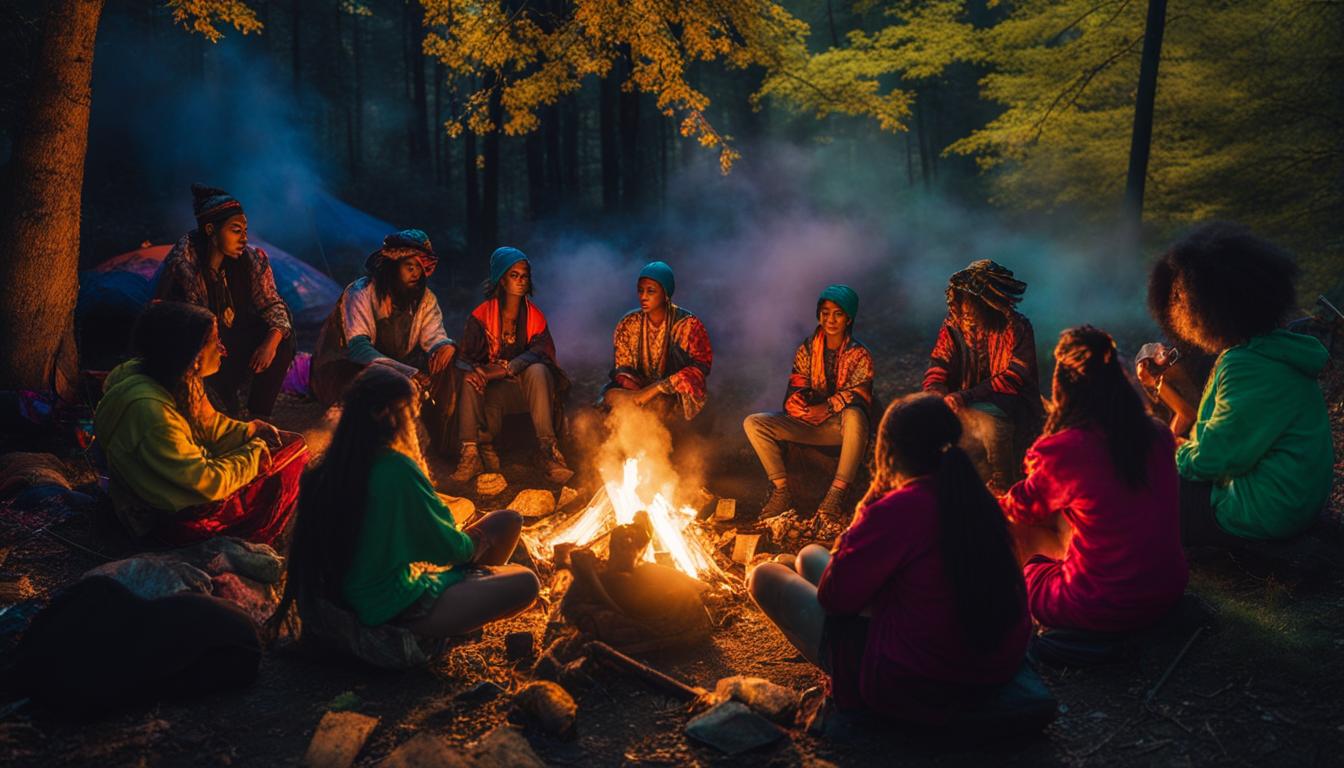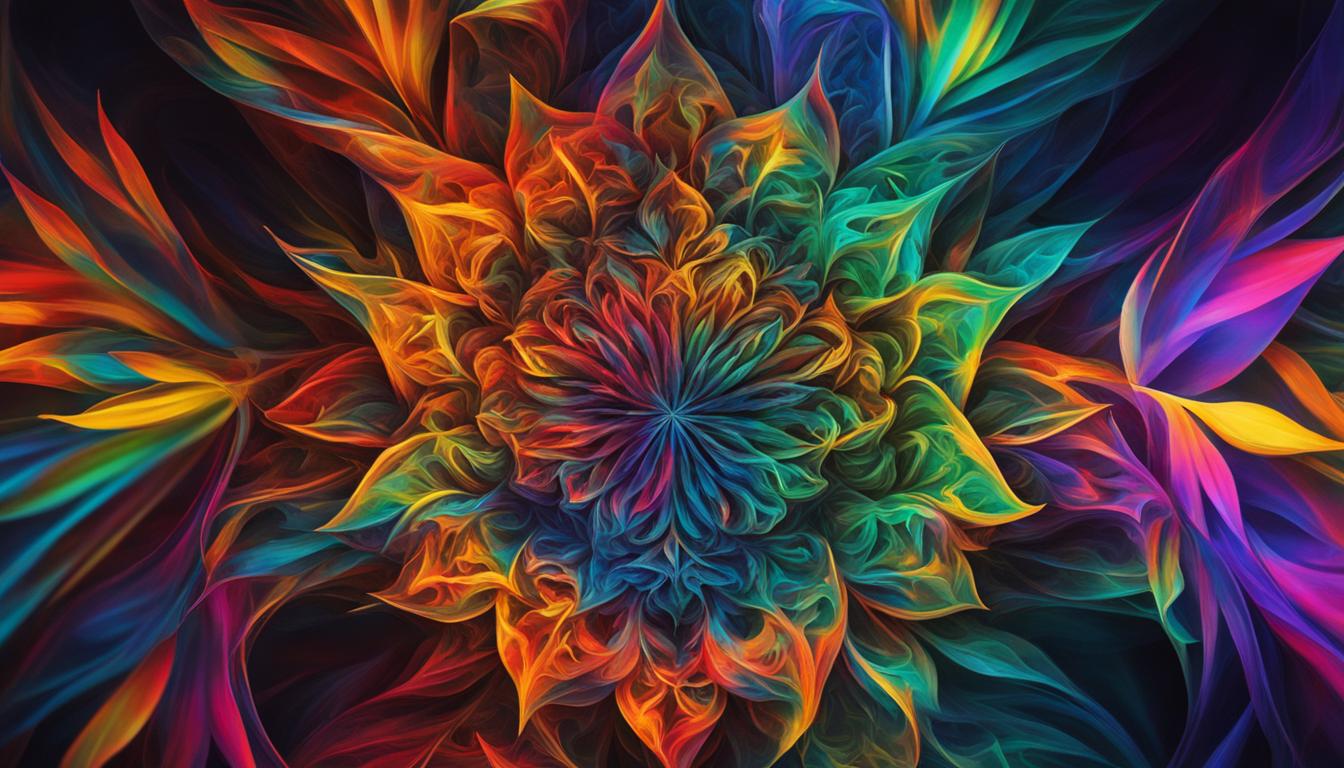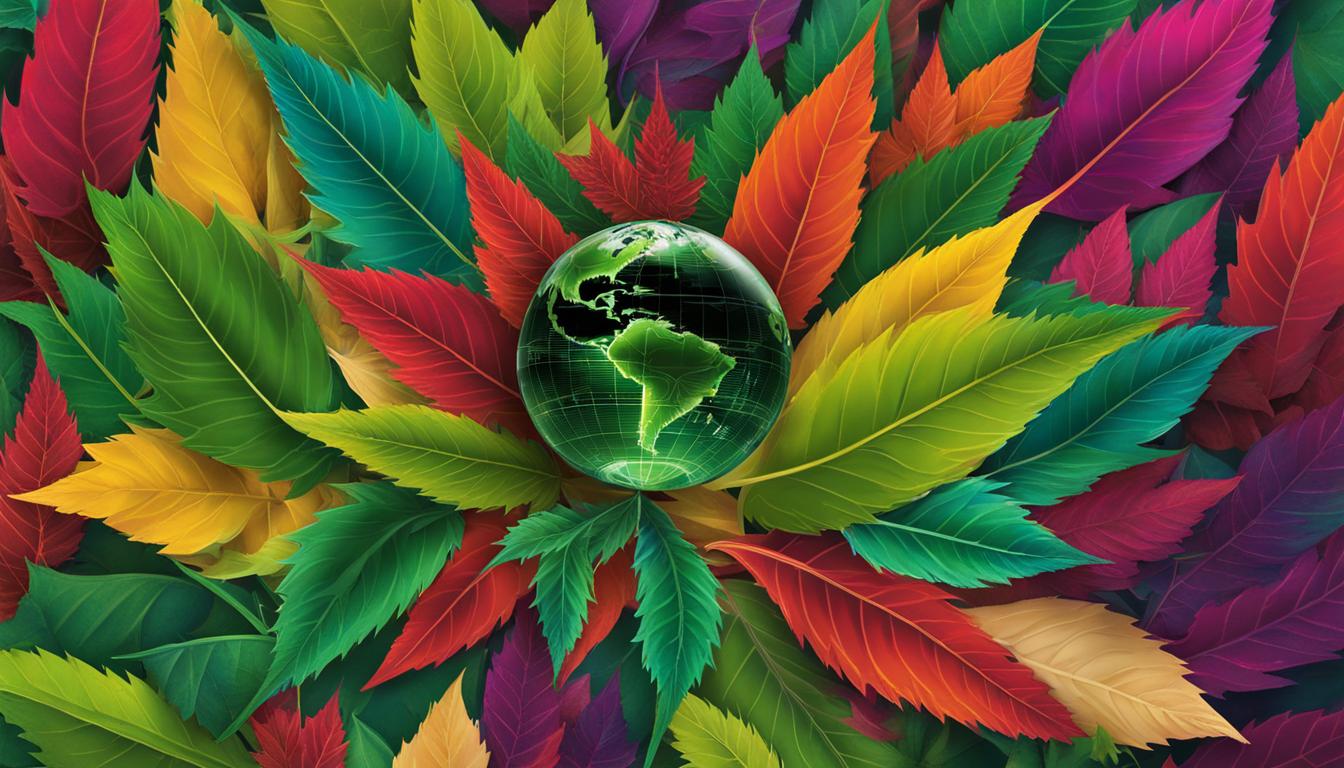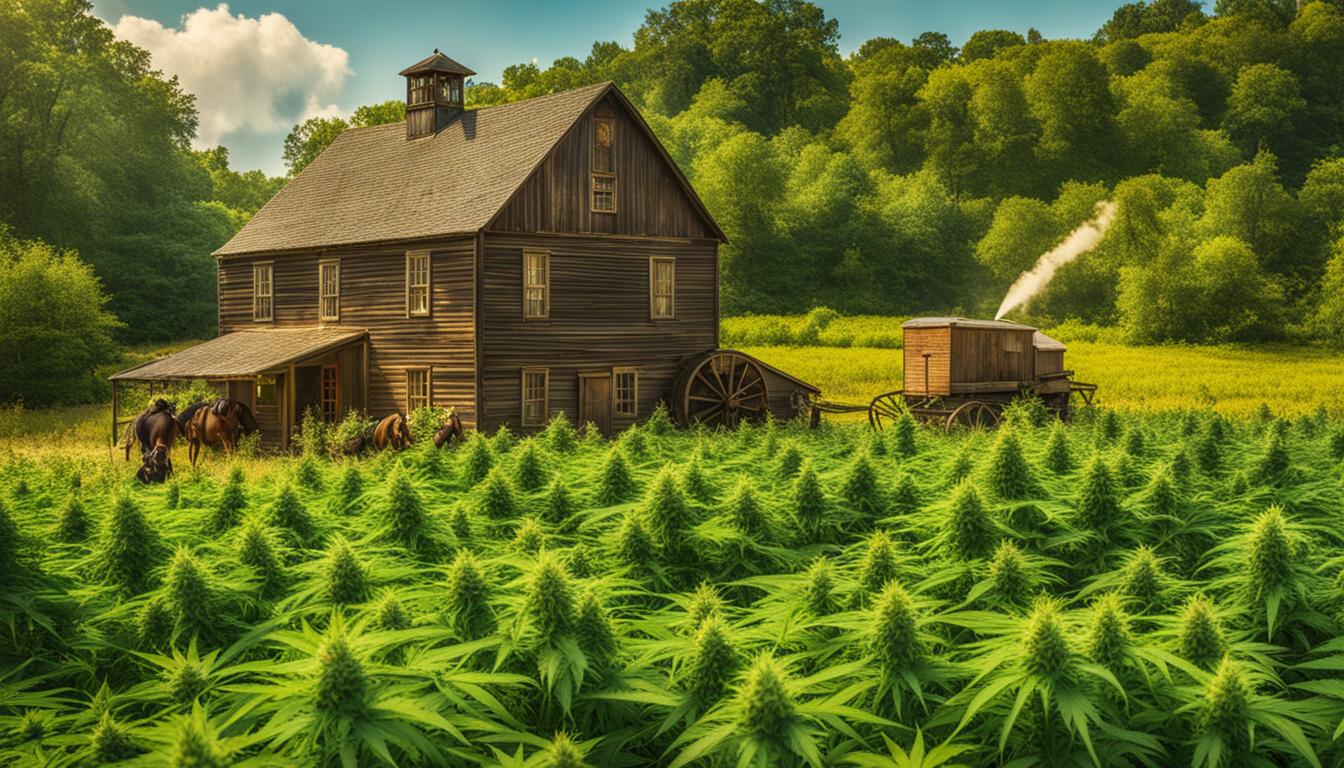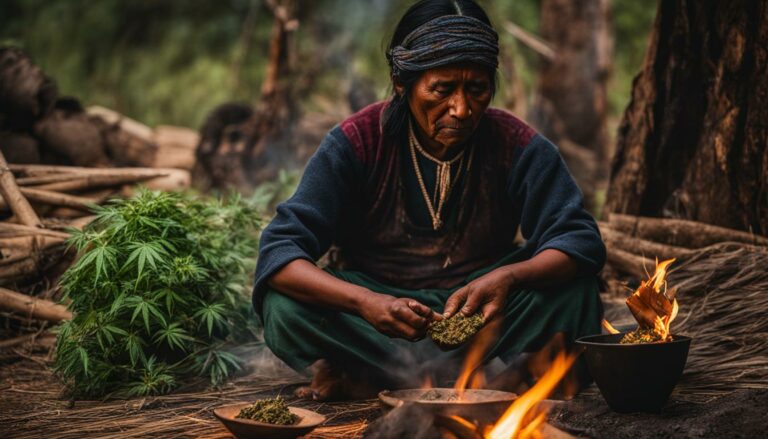1960s Counterculture and Cannabis
Experience the vibrant era of the 1960s counterculture movement, where rebellion and freedom flourished. At the heart of this cultural revolution was cannabis, a symbol of defiance against the status quo. The counterculture movements, inspired by the Civil Rights Movement and opposition to the Vietnam War, propelled cannabis into the mainstream consciousness. Its historic illegality and mind-expanding properties made it irresistible to those challenging societal norms.
Embrace the spirit of the counterculture movement and delve into the captivating world of cannabis culture. From its pivotal role in shaping the counterculture to its significance in the anti-establishment culture of the 60s and 70s, cannabis continues to inspire and empower.
Join us on a journey through time as we explore the origins of the counterculture, the intertwined relationship between cannabis and rebellion, and the evolution of cannabis culture in the modern era. Discover how artists have been influenced by cannabis, the impact of societal change on cannabis acceptance, and the future of this enlightening plant.
Unlock the secrets of the 1960s counterculture and the enduring legacy of cannabis. Let us delve into the rich tapestry of history and experience the transformative power of cannabis culture.
The Origins of Counterculture
The counterculture movements of the 1960s and 70s were a response to the prevailing social and political climate of the time. These movements emerged as a means of challenging the establishment and redefining societal norms. The counterculture of the 60s was particularly significant in its opposition to the status quo, driven by the Civil Rights Movement and the Vietnam War. It was during this time that cannabis became intertwined with counterculture ideals, embodying the spirit of rebellion and non-conformity.
The counterculture movements of the 1960s rejected traditional values and embraced alternative ways of thinking and living. Cannabis, with its historic illegality and psychedelic properties, resonated with the counterculture’s desire to break free from societal constraints. It became a symbol of the anti-establishment culture, a physical manifestation of the rejection of mainstream values. Cannabis use provided a sense of unity and solidarity among counterculture members, fostering a sense of community and shared experiences.
“Cannabis played a significant role in these movements, with its historic illegality and psychedelic properties aligning with counterculture ideals.
The counterculture movements of the 60s challenged existing power structures and advocated for social change. They sought to create a more egalitarian and inclusive society, rejecting the inequalities and injustices prevalent at the time. Cannabis served as both a catalyst and a symbol for these movements, embodying their spirit of resistance and defiance. Its association with counterculture ideals helped to shape public opinion and challenge the prevailing narrative surrounding cannabis.
| Counterculture Movement | Key Beliefs and Values |
|---|---|
| Hippie Movement | Peace, love, and harmony; rejection of materialism; embrace of communal living |
| Anti-War Movement | Opposition to the Vietnam War; calls for peace and non-violence |
| Civil Rights Movement | Fight for racial equality and social justice; empowerment of marginalized communities |
The counterculture movements of the 1960s and their association with cannabis have left a lasting impact on society. While the specific movements may have waned over time, their influence on cultural norms and attitudes towards cannabis remains. The origins of counterculture set the stage for the evolution of cannabis culture, leading to its eventual acceptance and mainstream adoption in the modern era.
Cannabis and Counterculture
In the 1960s, cannabis became closely intertwined with the counterculture movement, serving as a catalyst for activism and rebellion. Cannabis activism emerged as a central theme, advocating for the plant’s legalization and challenging societal norms surrounding drug culture. The marijuana revolution of the 1960s saw the drug becoming a symbol of counter-establishment culture, embraced by those seeking alternative perspectives and an escape from mainstream society.
The 1960s Drug Culture
The 1960s drug culture was characterized by experimentation and a rejection of traditional values. Cannabis played a significant role in this culture, offering a means of escape and a way to challenge authority. It became a symbol of youth rebellion and social dissent, with counterculture icons like Bob Dylan and Timothy Leary endorsing its use. The drug culture of the 1960s paved the way for a wider acceptance and appreciation of cannabis in society.
“Marijuana is not a drug; it’s a flower. Why I think it’s bad is because the government says it’s bad; I mean, come on! It’s just a plant.” – Willie Nelson
The Rise of Cannabis Activism
Cannabis activism gained momentum in the 1960s, driven by the counterculture’s desire for social change and the recognition of the plant’s potential. Activists fought for the decriminalization and legalization of cannabis, advocating for its medical benefits and challenging the criminalization of users. Their efforts laid the groundwork for the cannabis movement we see today, shaping public opinion and pushing for legislative reforms around the world.
| Year | Key Milestone |
|---|---|
| 1964 | The New York Times publishes an editorial supporting the decriminalization of marijuana |
| 1965 | Beat generation writer Allen Ginsberg introduces Bob Dylan to cannabis |
| 1968 | The National Organization for the Reform of Marijuana Laws (NORML) is founded |
The cannabis activism of the 1960s set the stage for the ongoing fight for cannabis rights and the recognition of its potential as a medicine and a source of cultural inspiration. It is through the efforts of these counterculture pioneers that we continue to see progress in cannabis acceptance and the dismantling of outdated stereotypes.
“The legalization of marijuana is not a dangerous experiment – the prohibition is the experiment, and it has failed dramatically, with millions of victims all around the world.” – Sebastian Marincolo
Cannabis as a Counterculture Subculture
Cannabis has not just been a part of counterculture movements; it has also developed its own subculture within these movements. This subculture encompasses its own language, symbols, and customs, creating a unique identity within the larger countercultural landscape.
Within the cannabis subculture, certain rituals and unwritten rules have emerged, further solidifying its distinctiveness. Cannabis festivals, where enthusiasts gather to celebrate and explore the plant’s various strains and consumption methods, are a prominent aspect of this subculture. These festivals provide a space for like-minded individuals to come together, share experiences, and embrace the cannabis lifestyle.
In addition to festivals, prominent figures within the cannabis community contribute to the subculture’s growth and recognition. Personalities such as Doug Benson and Willie Nelson have become icons within the cannabis subculture, using their platforms to advocate for cannabis acceptance and education.
The Rise of Cannabis Festivals
Cannabis festivals have become a significant part of the cannabis subculture. These events draw people from diverse backgrounds who share a passion for cannabis and its potential to foster community, creativity, and personal growth. From small-scale local gatherings to large-scale international events, cannabis festivals provide a platform for education, entertainment, and collaboration.
| Festival | Location | Description |
|---|---|---|
| High Times Cannabis Cup | Amsterdam, Netherlands | An iconic festival that brings together cannabis enthusiasts and industry professionals to celebrate the best strains, products, and innovations in the cannabis world. |
| Cannabis Liberation Day | Amsterdam, Netherlands | A protest and cultural event that advocates for the legalization of cannabis and promotes responsible use through music, art, and educational activities. |
| Spannabis | Barcelona, Spain | One of the largest cannabis trade shows in the world, showcasing the latest products, technologies, and developments in the cannabis industry. |
“Cannabis festivals provide a platform for like-minded individuals to come together, learn from each other, and celebrate the plant that has become a central part of their lives. These events foster a sense of community and belonging, reinforcing the shared values and interests of the cannabis subculture.”
As cannabis acceptance continues to grow, so does the influence and presence of the cannabis subculture. This subculture has its own unique characteristics that distinguish it from other countercultural movements, reflecting the particular relationship between cannabis enthusiasts and the plant itself. Cannabis festivals, along with the contributions of influential figures, play a critical role in nurturing and shaping the cannabis subculture, ensuring its continued growth and recognition.
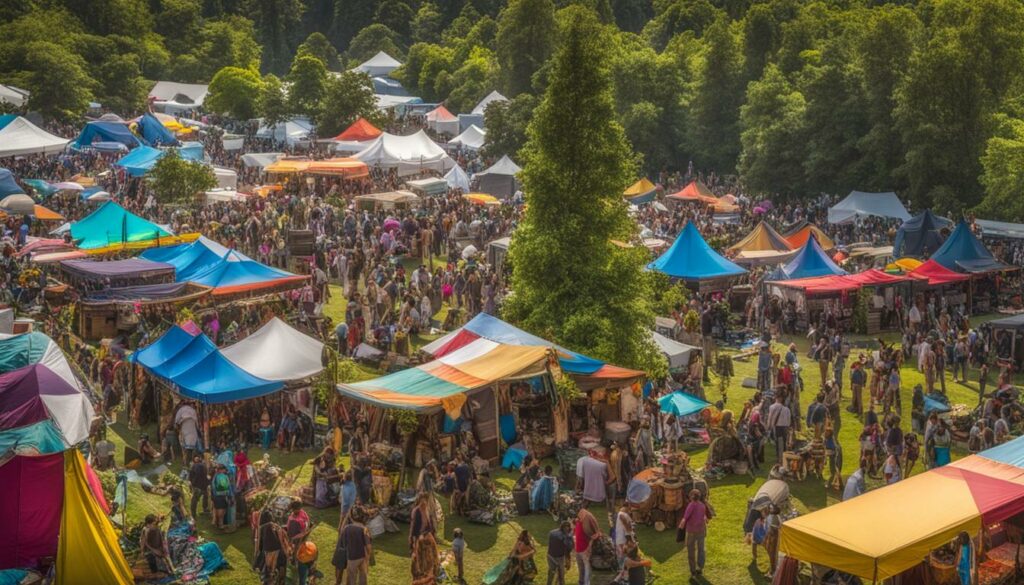
The Evolution of Cannabis Culture
Cannabis culture has experienced a significant evolution since the 1960s, driven by the process of marijuana legalization and increasing mainstream acceptance. As more states and countries embrace the recreational and medical use of cannabis, its perception has shifted from a symbol of rebellion to a legitimate industry with thriving cannabis businesses.
Cannabis Legalization and Mainstream Acceptance
The legalization of marijuana for both recreational and medical purposes has been a pivotal turning point in the evolution of cannabis culture. This policy change has challenged the stigma surrounding cannabis and normalized its use among a wide range of demographics. With its newfound legality, cannabis has gained recognition as a plant with potential benefits, leading to increased acceptance and integration into mainstream society.
“The legalization of cannabis has paved the way for the growth of a legitimate industry and the emergence of cannabis businesses.”
The Rise of Cannabis Businesses
The legalization of cannabis has paved the way for the growth of a legitimate industry, fostering innovation and entrepreneurship. Cannabis businesses have flourished, ranging from dispensaries and cultivation operations to cannabis-infused product manufacturers and delivery services. Entrepreneurs and investors have recognized the economic potential of the cannabis market, leading to the establishment of diverse businesses catering to different consumer preferences.
The cannabis industry has not only created employment opportunities but has also generated substantial tax revenue for local economies. This economic impact has further contributed to the mainstream acceptance of cannabis by highlighting its potential as a lucrative market and a catalyst for economic growth.
| Benefits of Cannabis Legalization and Mainstream Acceptance | Impact on Cannabis Culture |
|---|---|
| Access to safe and regulated cannabis products | The normalization of cannabis use |
| Economic growth and job creation | The rise of cannabis-related businesses |
| Tax revenue for local governments | The destigmatization of cannabis |
| Increased research opportunities on cannabis | The integration of cannabis into mainstream society |
The evolution of cannabis culture has come a long way from its counterculture roots in the 1960s. With marijuana legalization and mainstream acceptance, the perception of cannabis has transformed, paving the way for a thriving industry and a more inclusive culture. As attitudes towards cannabis continue to evolve, it is anticipated that cannabis culture will further expand and diversify, embracing new innovations and societal changes.
The Influence of the 1960s Counterculture Movement
The counterculture movements of the 1960s marked a cultural revolution that brought about significant social change and acceptance of cannabis. This transformative era challenged societal norms, promoting peace, love, and freedom. Cannabis became intertwined with this movement, symbolizing rebellion against the establishment and inspiring a generation to challenge existing beliefs.
“The counterculture movement of the 1960s was a powerful force for social change. It challenged the status quo, fought for civil rights, and called for an end to the Vietnam War. Cannabis played a significant role in this movement, representing a symbol of resistance and a means of exploring alternative perspectives and consciousness.”
The counterculture activists of the time fought for equal rights and social progress, leaving a lasting impact on the perception and acceptance of cannabis in society. It became a symbol of unity and a catalyst for questioning the existing power structures. The ideals of the counterculture movement continue to resonate today, shaping the ongoing evolution of cannabis culture and its acceptance in mainstream society.
The 1960s counterculture movement not only brought cannabis to the forefront of social consciousness but also paved the way for future generations to challenge norms and pursue social change. It sparked a cultural revolution that continues to inspire individuals to question authority and promote acceptance, freedom, and equality. The influence of this movement on cannabis culture is undeniable, as it continues to shape the way society perceives and embraces the plant.
| Key Points | Cultural Revolution | Social Change | Cannabis Acceptance |
|---|---|---|---|
| Impact of counterculture movements | ✓ | ✓ | ✓ |
| Cannabis as a symbol of rebellion | ✓ | ✓ | |
| Counterculture activists’ influence on cannabis acceptance | ✓ | ✓ | |
| Long-lasting impact on cannabis culture | ✓ | ✓ |
Cannabis and Innovation
The counterculture movements of the 1960s and 70s sparked a wave of innovation in the use of cannabis. As hippies and counterculture activists sought alternative ways of experiencing the plant, they experimented with new methods of consumption and incorporation into various products. This spirit of exploration and openness led to the development of cannabis-infused products and techniques that continue to shape the industry today.
One of the key innovations that emerged during this time was the creation of cannabis-infused edibles. People began incorporating cannabis into recipes, resulting in a variety of delicious and potent treats. From classic brownies to gourmet chocolates, cannabis-infused edibles became a popular and discreet way to consume the plant. This innovation opened up new possibilities for cannabis use and attracted individuals who were interested in exploring alternative methods of consumption.
Another innovative approach that emerged from the counterculture movements was the development of cannabis concentrates. These highly potent forms of cannabis, such as wax, shatter, and oils, gained popularity due to their higher levels of cannabinoids and terpenes. Concentrates allowed users to experience the effects of cannabis more intensely and efficiently. This innovation revolutionized the way cannabis was consumed and opened up new avenues for medical and recreational users.
The counterculture movements of the 1960s and 70s sparked a wave of innovation in the use of cannabis.
The Impact of Innovation
The innovations that emerged from the counterculture movements of the 1960s revolutionized the cannabis industry and paved the way for its modern-day growth and acceptance. Today, cannabis-infused products have expanded beyond edibles to include a wide range of options such as beverages, topicals, and even pet products. These innovations have made cannabis more accessible to a broader audience and have helped to destigmatize its use.
| Innovation | Description |
|---|---|
| Cannabis-Infused Edibles | Food and beverages infused with cannabis, providing a discreet and potent way to consume the plant. |
| Cannabis Concentrates | Highly potent forms of cannabis that offer a more intense and efficient way to experience its effects. |
| Expanding Product Range | Cannabis-infused products now include a wide range of options, catering to different preferences and needs. |
Furthermore, these innovations have fueled the growth of the cannabis industry, creating new business opportunities and driving economic development. Entrepreneurs and innovators have capitalized on the changing attitudes towards cannabis, leading to the establishment of successful companies that specialize in cannabis-infused products. This industry has created jobs, generated tax revenue, and contributed to local and national economies.
The counterculture movements of the 1960s and 70s not only challenged societal norms but also sparked a wave of cannabis innovation. From the development of edibles to the creation of cannabis concentrates, these innovations have had a profound impact on the industry and paved the way for the modern cannabis culture we see today. As the industry continues to evolve, it is likely that we will see even more groundbreaking innovations that push the boundaries of what is possible with cannabis.
Cannabis Culture in the Modern Era
The legalization of cannabis has transformed it from a counterculture symbol to a thriving industry. In the modern era, cannabis has broken free from its rebellious roots and found its place in mainstream society. The cannabis industry has experienced remarkable growth, attracting entrepreneurs from all walks of life. With the acceptance and recognition of cannabis’s potential benefits, the industry continues to expand, creating new opportunities and driving innovation.
“The cannabis industry is a powerful force for change and entrepreneurship, offering a wide range of possibilities for individuals to make their mark.” – Industry Expert
The rise of the cannabis industry has brought about a wave of entrepreneurship. From cannabis cultivation and retail to infused products and technology, there are countless avenues for individuals to enter the market. The industry’s rapid growth has created a demand for specialized expertise and innovative solutions. Entrepreneurs are seizing the opportunity to build successful businesses and shape the future of cannabis.
Table: Cannabis Industry Opportunities
| Industry Sector | Opportunities |
|---|---|
| Cultivation | Indoor and outdoor cultivation, strain breeding, sustainable practices |
| Retail | Dispensaries, online platforms, delivery services |
| Infused Products | Edibles, beverages, topicals, wellness products |
| Technology | Seed-to-sale software, cannabis analytics, vape technology |
| Research and Development | New product development, extraction methods, medical research |
Entrepreneurship in the cannabis industry goes beyond profit-making. Many entrepreneurs are driven by a desire to challenge stigma and promote social change. The cannabis industry has become a platform for advocating for legalization, social equity, and justice. Entrepreneurs are actively working to break down barriers and create an inclusive industry that reflects the values of the counterculture movements that inspired its origins.
The future of cannabis culture lies in the hands of these entrepreneurs, innovators, and advocates. As the industry continues to evolve and cannabis acceptance grows, there will be new opportunities for individuals to make a meaningful impact. Whether it’s through business ventures, activism, or technological advancements, the cannabis industry offers a unique space for entrepreneurial spirit and societal change.

The Future of Cannabis Culture
The future of cannabis culture holds immense potential for societal change and the development of progressive policies. As attitudes towards cannabis continue to evolve, there is a growing recognition of its benefits and potential uses. The ongoing legalization efforts and policy changes surrounding cannabis present an opportunity to shape the future landscape of cannabis culture.
Cannabis policy change efforts are crucial in creating a more inclusive and equitable industry. Activists and advocates are pushing for social equity, justice, and fair access to the benefits of cannabis. As cannabis becomes more widely accepted, it is vital to ensure that communities disproportionately affected by the war on drugs have a seat at the table. The future of cannabis culture should prioritize diversity, inclusivity, and the empowerment of marginalized communities.
“The future belongs to those who believe in the potential of cannabis to heal, inspire, and drive positive change.”
With the potential for cannabis to revolutionize various industries, including healthcare, wellness, and sustainability, the future of cannabis culture is not limited to recreational use. As research continues to uncover the therapeutic properties and potential applications of cannabis, it is likely to become a mainstream option for medical and wellness purposes. The integration of cannabis into traditional healthcare systems and the development of innovative cannabis-infused products will shape the future of cannabis culture.
| Key Factors Shaping the Future of Cannabis Culture | Impact |
|---|---|
| Legalization and policy reforms | A shift towards a more accepting and regulated environment. |
| Research and innovation | Advancements in understanding the benefits and potential uses of cannabis. |
| Industry growth and entrepreneurship | Creation of new opportunities and economic growth. |
| Social equity and justice | Promotion of inclusivity and empowerment in the cannabis industry. |
| Changing societal attitudes | Increased acceptance and recognition of cannabis as a legitimate option. |
As we look to the future, it is clear that cannabis culture will continue to evolve and shape society. The potential benefits of cannabis, coupled with changing perspectives and policy changes, contribute to an exciting and promising future for cannabis culture. Embracing inclusivity, social equity, and innovation will be key in shaping a future that celebrates the positive impact of cannabis on individuals, communities, and industries.
The Influence of Artists on Cannabis Culture
Artists have always been at the forefront of cultural movements, challenging societal norms and pushing boundaries. The counterculture movements of the 1960s were no exception, and artists played a significant role in shaping and influencing cannabis culture during that time. Through their artwork, literature, and music, artists celebrated cannabis as a symbol of freedom, creativity, and rebellion against the status quo.
Artists embraced cannabis as a muse, finding inspiration in its ability to enhance creativity and provide a different perspective on the world. The psychedelic qualities of cannabis influenced their artistic expression, resulting in vibrant and thought-provoking works that challenged conventional norms and explored new realms of consciousness.
“Cannabis brings you into the moment… It heightens your senses, your awareness. It definitely makes you more creative.” – Bob Marley
The influence of artists on cannabis culture extends beyond the counterculture movements of the 1960s. Even today, artists continue to explore and depict cannabis in their work, reflecting its ongoing impact on society and culture. They use various mediums, such as painting, sculpture, photography, and film, to capture the essence of cannabis and its transformative power.
The Intersection of Cannabis and Creativity
The connection between cannabis and creativity is often celebrated and studied. Many artists have found that cannabis enhances their creative process, allowing them to tap into their imagination and break free from conventional thinking. It can help unlock new ideas, provide a fresh perspective, and ignite innovative thinking.
Research has shown that cannabis can increase divergent thinking, which is the ability to generate a wide range of ideas and solutions. It can also enhance the quality of creative output, leading to more original and unique works of art. The cannabis-inspired creativity that artists bring to the world continues to shape and redefine cannabis culture, inspiring others to explore their own creative potential.
Inspiring Cultural Shifts
The influence of artists on cannabis culture extends beyond the realm of creativity. Their advocacy for cannabis legalization and their willingness to challenge societal stigmas have played a crucial role in shaping public opinion and driving cultural shifts. Through their art and activism, they have helped to break down barriers and foster a more inclusive and accepting society.
Artists have been instrumental in humanizing cannabis and showcasing its positive impact on individuals and communities. Their work has helped to dismantle stereotypes and challenge negative perceptions, paving the way for a more enlightened approach to cannabis use and policy.
The Enduring Impact
The influence of artists on cannabis culture is enduring and continues to evolve. Their fearless exploration of cannabis and its potential has opened doors for others to embrace its benefits and appreciate its beauty. As cannabis culture continues to evolve, artists will undoubtedly remain at the forefront, shaping the narrative and inspiring new generations to challenge the boundaries of creativity and consciousness.
Cannabis and Societal Change
The acceptance and visibility of cannabis have undergone significant changes over time. From its origins as a symbol of rebellion in the counterculture movements of the 1960s to its current legalization and mainstream acceptance, cannabis has become increasingly integrated into society. As people gain a better understanding of its effects and potential benefits, attitudes towards cannabis continue to evolve. The ongoing societal change reflects the transformative power of cannabis and its ability to challenge existing beliefs and norms.
“Cannabis has the potential to revolutionize our society by offering alternative perspectives and solutions to longstanding issues. Its acceptance and growing visibility indicate a shift towards a more open-minded and progressive society. As we embrace cannabis as a legitimate option for medical and wellness purposes, we pave the way for a more inclusive and compassionate future.”
The increasing acceptance of cannabis is evident not only in its legalization but also in the shifting cultural perceptions surrounding the plant. With the visibility of cannabis increasing, conversations around its benefits and potential have become more common. As a result, more people are exploring how cannabis can enhance their lives, whether for therapeutic purposes or as a tool for relaxation and creativity. This growing acceptance indicates a shift in societal attitudes towards cannabis and underscores its potential to bring about positive change.
In conclusion, the acceptance and visibility of cannabis have evolved significantly over time. From its role in counterculture movements to its current mainstream acceptance, cannabis has challenged societal norms and begun to reshape our understanding of wellness and alternative lifestyles. As cannabis culture continues to grow and thrive, it is important to engage in open and informed discussions surrounding the plant’s benefits and potential risks. By embracing cannabis as a catalyst for societal change, we can truly harness its transformational power and create a more progressive and inclusive society.
Conclusion
The counterculture movements of the 1960s sparked a revolution in society, with cannabis at the forefront. From its roots as a symbol of rebellion, cannabis has transcended into a mainstream phenomenon. The acceptance and legalization of cannabis reflect the evolving attitudes towards this plant and its potential for societal transformation.
Looking ahead, the future of cannabis culture holds immense promise for cannabis enlightenment. As we continue to explore the benefits of cannabis, we uncover its potential to bring about profound societal change. The ongoing acceptance and recognition of cannabis as a legitimate option for medical and wellness purposes indicate a shift in collective consciousness.
The story of cannabis’s connection to counterculture in the 1960s is just the beginning. As we embrace the enlightenment that cannabis offers, we have the power to shape a more open-minded and accepting society. Let us continue to explore the possibilities and potential of cannabis culture, guided by the lessons of the past and the aspirations of a brighter future.
Inspire the change with 1960s Cannabis Counterculture and embrace the cannabis enlightenment!
FAQ
What were the counterculture movements of the 1960s and 70s?
The counterculture movements of the 1960s and 70s were social revolutions that challenged mainstream society and its norms. They included the Civil Rights Movement and opposition to the Vietnam War.
What role did cannabis play in the counterculture movements?
Cannabis became a symbol of rebellion and non-conformity during the counterculture movements. Its historic illegality and psychedelic properties aligned with counterculture ideals, making it appealing to those challenging societal norms.
How has cannabis culture evolved since the 1960s?
With the legalization of marijuana in many states, cannabis has become more mainstream and accepted by a diverse cross-section of society. Cannabis businesses have flourished, and public figures openly advocate for its use.
What impact did the counterculture movements have on cannabis culture?
The counterculture movements of the 1960s challenged societal norms and beliefs, and cannabis became intertwined with these movements. It became a symbol of peace, love, and freedom and had a lasting influence on the perception and acceptance of cannabis in society.
How did artists influence cannabis culture?
Artists, through their artwork, literature, and music, celebrated cannabis and its connection to freedom and creativity during the counterculture movements. They continue to explore and depict cannabis in their work, reflecting its ongoing impact on society and culture.
What is the future of cannabis culture?
As societal perspectives on cannabis continue to shift, the acceptance and recognition of its benefits are likely to grow. Cannabis has the potential to help people in various ways and is increasingly accepted for medical and wellness purposes. The future of cannabis culture holds immense potential for societal change and enlightenment.
How has cannabis acceptance and visibility changed over time?
From its origins as a symbol of rebellion, cannabis has become increasingly integrated into society. As people gain a better understanding of its effects and potential benefits, attitudes towards cannabis continue to evolve, reflecting its transformative power and ability to challenge existing beliefs and norms.
Source Links
- https://e1011labs.com/blogs/news/how-cannabis-became-part-of-american-counterculture
- https://flowershopdispensary.com/from-counterculture-to-mainstream-the-evolution-of-cannabis-culture/
- https://www.vibebycalifornia.com/the-flower-power-revolution-how-the-1960s-counterculture-shaped-modern-cannabis/

